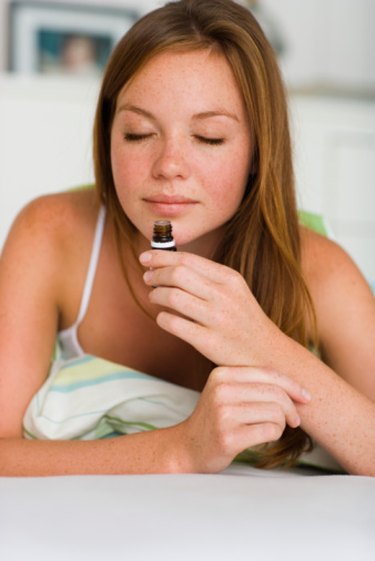Things You'll Need
1 tablespoon of jojoba carrier oil
3 different essential oils of your choice (in glass bottles with dropper tops)
1 to 2 drops liquid glycerin
Glass mixing container
Glass stirring rod
Airtight 1-ounce blue or amber glass container

Making perfume from essential oils is a fun way to create your own unique scent. However, depending on the essential oils you use, the fragrance of your homemade blend may fade within a couple of hours. Thankfully, you can boost your blend's staying-power by diluting your essential oils in jojoba oil, adding a fixative such as glycerin, and storing your finished perfume correctly. There are no hard and fast rules when it comes to blending essential oil, it is all about experimentation and your own personal preference. Following some simple guidelines will help you get started.
Step 1
Pour the jojoba oil into a glass mixing container. This is your base.
Video of the Day
Step 2
Select three different essential oils: a low note, a middle note and a high note, preferably from the same fragrance family or from complementary fragrance families. For example, you might chose sandalwood, rosewood and lemongrass from the woodsy family.
Step 3
Add one drop of a low note essential oil to your base. Stir in well using a glass stirring rod.
Step 4
Add two drops of a complementary middle note essential oil to the blend. Stir in well.
Step 5
Add three drops of a complementary high note essential oil to the blend. Stir in well.
Step 6
Inhale your blend and determine if it is the desired strength.
Step 7
Repeat steps 3 through 6 up to a maximum of 25 drops or until you reach the desired strength of the scent you are creating.
Step 8
Add the glycerin to your blend. Stir in well.
Step 9
Pour your blend into a 1-ounce airtight blue or amber glass storage bottle. Screw the lid on tightly and shake well.
Step 10
Leave your perfume to sit in a dark, cool place for a few days, shaking daily, before use. Do not open the container during this time. This allows all the oils you have combined to blend properly.
Tip
Familiarize yourself with the different categories of essential oils before making your own blend to help you select complementary scents.
Combine oils with top, middle and base notes that complement each other. Achieve this by choosing essential oils from within the same fragrance family (floral, woodsy etc), or by combining families that blend well together. As a general guide: florals blend well with spicy, citrus and woodsy oils; woodsy oils blend well with all categories; spicy and oriental oils blend well with florals and citrus oils; minty oils blend well with citrus, woodsy, herbaceous and earthy oils.
Make a note of your recipe as you experiment so you can duplicate your perfect blend in the future.
Treat the above blending advice as a general guide only. All essential oils have different properties and some are stronger than others so always trust your nose when deciding which combination of essential oils to use and how much of each to add.
Store your essential oil perfume in a cool, dark place to prevent evaporation.
Warning
Perform a skin patch test to check for possible allergic reactions before using glycerin or essential oils. Apply glycerin or diluted essential oil to a small patch of skin on your inner arm. If redness, burning, itching, or irritation occurs over a 48-hour period, do not use.
Never consume or apply undiluted essential oils to the skin. Do not apply blends with more than a 50 percent dilution of essential oils to the skin.
Concoct your blend in a room with good ventilation.
Store your essential oil perfume out of reach of children and away from medicines.
Video of the Day